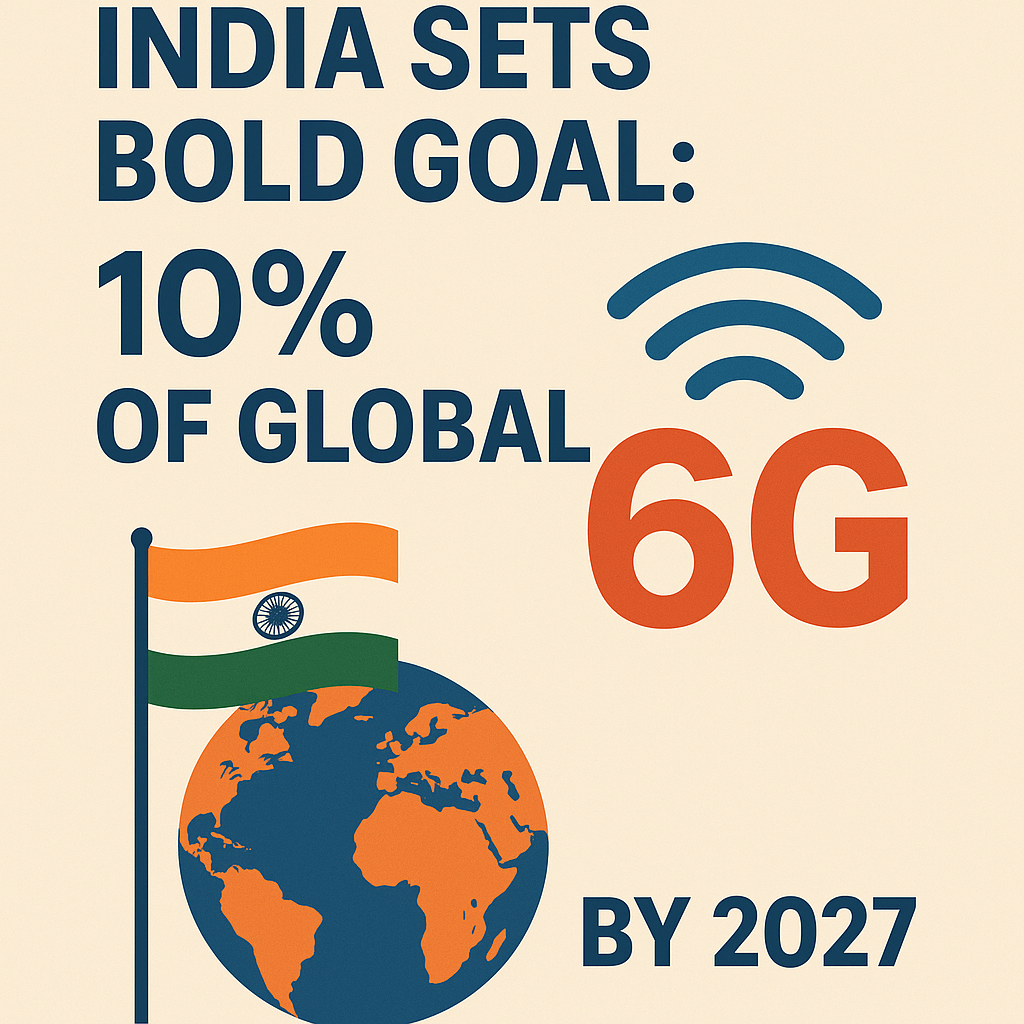Introduction: India’s Strategic Leap into the 6G Era
In a groundbreaking declaration, Union Minister of Communications Jyotiraditya Scindia revealed that India aims to contribute 10% of global 6G patents by 2027. This announcement marks a major turning point in India's ambitions to become a dominant force in future telecommunications—going beyond consumer adoption and stepping into global innovation and standardization.
With countries like the US, China, South Korea, and Japan already making strides in 6G research, India’s move to secure intellectual property (IP) and standardization rights sends a strong signal: India is no longer just a follower but a future-shaper in the wireless world.
Why Patents Matter in the 6G Race
In the global tech ecosystem, patents are power. Whoever holds the most patents in core technologies essentially controls the future of that industry. In the case of 6G, these patents influence:
- Network protocols
- Device and chipset architectures
- Spectrum allocation frameworks
- Security standards
- Interoperability across platforms and borders
By aiming for 10% of the global 6G patent pool, India is trying to ensure strategic leverage, reduce reliance on foreign tech, and monetize its IP globally.
India’s Current Position in the 6G Patent Landscape
As of mid-2025, India already ranks among the top six countries in 6G patent filings. This is a remarkable leap from previous generations of telecom standards (3G, 4G, 5G), where India’s contribution was largely peripheral.
According to data shared by the Department of Telecommunications (DoT) and industry experts:
- Indian entities have filed hundreds of 6G patents through both public and private institutions.
- Several patent proposals have already been accepted by global standardization bodies like 3GPP and ITU.
- Core contributions include areas like AI-native networks, energy-efficient protocols, non-terrestrial communication, and cyber-physical security.
Enter the Bharat 6G Alliance (B6GA)
A critical catalyst in India’s 6G mission is the Bharat 6G Alliance (B6GA), launched in 2023 as a multi-stakeholder body to unify efforts from:
- Academia (e.g., IITs, IISc)
- Startups & R&D labs
- Telecom majors like BSNL, Reliance Jio, Airtel
- Semiconductor and hardware manufacturers
- Government think tanks
With over 80+ active members, including 30+ innovative startups, B6GA functions through seven specialized working groups. These groups focus on:
- Spectrum and Devices
- Sustainability & Green Networks
- RAN & Core Network Design
- Global Collaboration & Policy
- Standards & Compliance
- Indigenous Component Manufacturing
- Applications & Use Cases
This ecosystem-driven model ensures that India’s 6G development is collaborative, diverse, and scalable.
Government Support and R&D Funding
India’s 6G vision is not just an idea—it's a fully funded mission.
Key initiatives include:
- Bharat 6G Vision Document, released in March 2023, outlining core principles for 6G leadership.
- Budget of ₹239–300 crore allocated to 111+ R&D projects, focusing on patentable research and tech prototypes.
- Monthly progress tracking and bi-annual high-level reviews by the Ministry of Communications.
- Empowerment of IITs and other institutions to accelerate patent filings, particularly in advanced technologies like:
- Terahertz spectrum
- Millimeter-wave communication
- AI/ML optimization in wireless systems
- Next-gen security protocols
- Holographic beamforming
The goal is clear: File, publish, and standardize—all by 2027.
IIT-Kanpur and India’s Role in Global Standardization
At the heart of India's global influence in 6G is IIT-Kanpur, especially the work of Prof. Rohit Budhiraja, who leads India's representation in key international working groups.
According to Prof. Budhiraja:
"India is not just participating. We are shaping the future standards. Our proposals are now being adopted globally, especially in AI-native network design and secure device-to-device communication."
The active involvement of Indian researchers in 3GPP’s Release 20 and Release 21, which will form the technical backbone of 6G globally, demonstrates that India’s voice is being heard where it matters most.
The Bigger Picture: 6G as a $1 Trillion Opportunity
India’s 6G mission is not just about patents or prestige. It’s about economic transformation.
A recent estimate by industry bodies suggests that successful participation in 6G R&D and deployment could contribute over $1 trillion to India’s economy by 2035. This impact includes:
- Export of telecom IP and hardware
- Creation of new jobs in R&D, manufacturing, and services
- Boost in startups focused on deep-tech, semiconductors, and AI
- Enhancing India’s role in global digital governance
India vs China: The Silent Tech War
While India pushes for democratic, open-source, and sustainable 6G ecosystems, China is also advancing fast, especially in defense-related 6G applications.
Recently, a Chinese university developed a 6G-photonic-based electronic warfare system capable of spoofing military radars. This underscores the strategic importance of 6G not just in telecom but also in national security and geopolitics.
India’s alignment with global democracies in developing transparent, ethical 6G standards is an important counterbalance to authoritarian tech models.
Challenges Ahead
Despite momentum, India must address key challenges:
- Low conversion rate of filed patents to accepted standards
- Bridging academia-industry gaps in commercializing research
- Semiconductor manufacturing bottlenecks
- Spectrum policy delays for THz bands
- Skilled talent pipeline in AI, quantum, and photonics
Addressing these through consistent policy, investment, and international partnerships will determine whether India meets its 2027 goal or falls short.
Conclusion: 6G as India’s Technological Renaissance
India’s push to own 10% of global 6G patents by 2027 is more than a milestone—it’s a signal to the world that India is ready to lead in deep-tech innovation.
With the right alignment of policy, academia, industry, and global diplomacy, India is not just preparing for 6G — it is helping define it.
If executed with vision and discipline, this mission can place India among the top three global tech powers in telecommunications—forever changing its role in the digital future.



